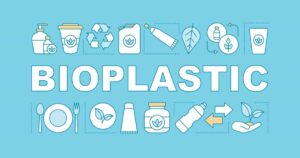PRELIMS Bits

- Bioplastics are plastics derived from renewable biological sources (like plants, starch, cellulose) instead of conventional petroleum-based plastics.
- Some bioplastics are biodegradable, while others are non-biodegradable but bio-based.
Types of Bioplastics
- Starch-based Plastics
- Made from corn, potato, or cassava starch.
- Biodegradable and often used in packaging.
- Polylactic Acid (PLA)
- Derived from fermented plant sugars.
- Used for bottles, food packaging, disposable cutlery.
- Polyhydroxyalkanoates (PHA/PHB)
- Produced by bacterial fermentation of sugars or lipids.
- Completely biodegradable.
- Cellulose-based Plastics
- Made from plant cellulose.
- Often used in films, coatings, and textiles.
Advantages
- Environmentally Friendly: Reduces dependence on fossil fuels.
- Biodegradability: Some types decompose naturally, reducing plastic waste.
- Lower Carbon Footprint: Less greenhouse gas emissions compared to conventional plastics.
- Renewable Source: Made from crops or waste biomass.
Limitations / Challenges
- Cost: More expensive than conventional plastics.
- Performance: Some bioplastics have lower durability and heat resistance.
- Industrial Composting Needed: Some types require special conditions to biodegrade.
- Competition with Food Crops: Uses agricultural resources that could be used for food.
Applications
- Packaging (bags, bottles, disposable cutlery)
- Agriculture (mulch films)
- Textiles and clothing
- Medical applications (sutures, implants)
Government Initiatives (India)
- Plastic Waste Management Rules, 2016: Encourages biodegradable plastics.
- FSSAI and BIS standards for compostable plastics.
- Promotion under Make in India and Bioeconomy Mission.




